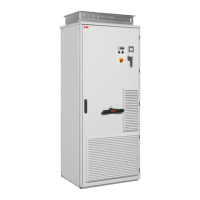Safe torque off function 147
Abbreviations
Abbr. Reference Description
Cat. EN ISO 13849-1 Classification of the safety-related parts of a control system in respect
of their resistance to faults and their subsequent behavior in the fault
condition, and which is achieved by the structural arrangement of the
parts, fault detection and/or by their reliability. The categories are: B, 1,
2, 3 and 4.
CCF EN ISO 13849-1 Common cause failure (%)
DC EN ISO 13849-1 Diagnostic coverage
HFT IEC 61508 Hardware fault tolerance
MTTF
d
EN ISO 13849-1 Mean time to dangerous failure: (The total number of life units) / (the
number of dangerous, undetected failures) during a particular
measurement interval under stated conditions
PFD IEC 61508 Probability of failure on demand
PFH IEC 61508 Probability of dangerous failures per hour
PL EN ISO 13849-1 Performance level. Levels a…e correspond to SIL
SC IEC 61508 Systematic capability
SFF IEC 61508 Safe failure fraction (%)
SIL IEC 61508 Safety integrity level (1…3)
SILCL IEC/EN 62061 Maximum SIL (level 1…3) that can be claimed for a safety function or
subsystem
SS1 IEC/EN 61800-5-2 Safe stop 1
STO IEC/EN 61800-5-2 Safe torque off
T1 IEC 61508-6 Proof test interval. T1 is a parameter used to define the probabilistic
failure rate (PFH or PFD) for the safety function or subsystem.
Performing a proof test at a maximum interval of T1 is required to keep
the SIL capability valid. The same interval must be followed to keep the
PL capability (EN ISO 13849) valid. Note that any T1 values given
cannot be regarded as a guarantee or warranty.
See also section Maintenance (page 99).

